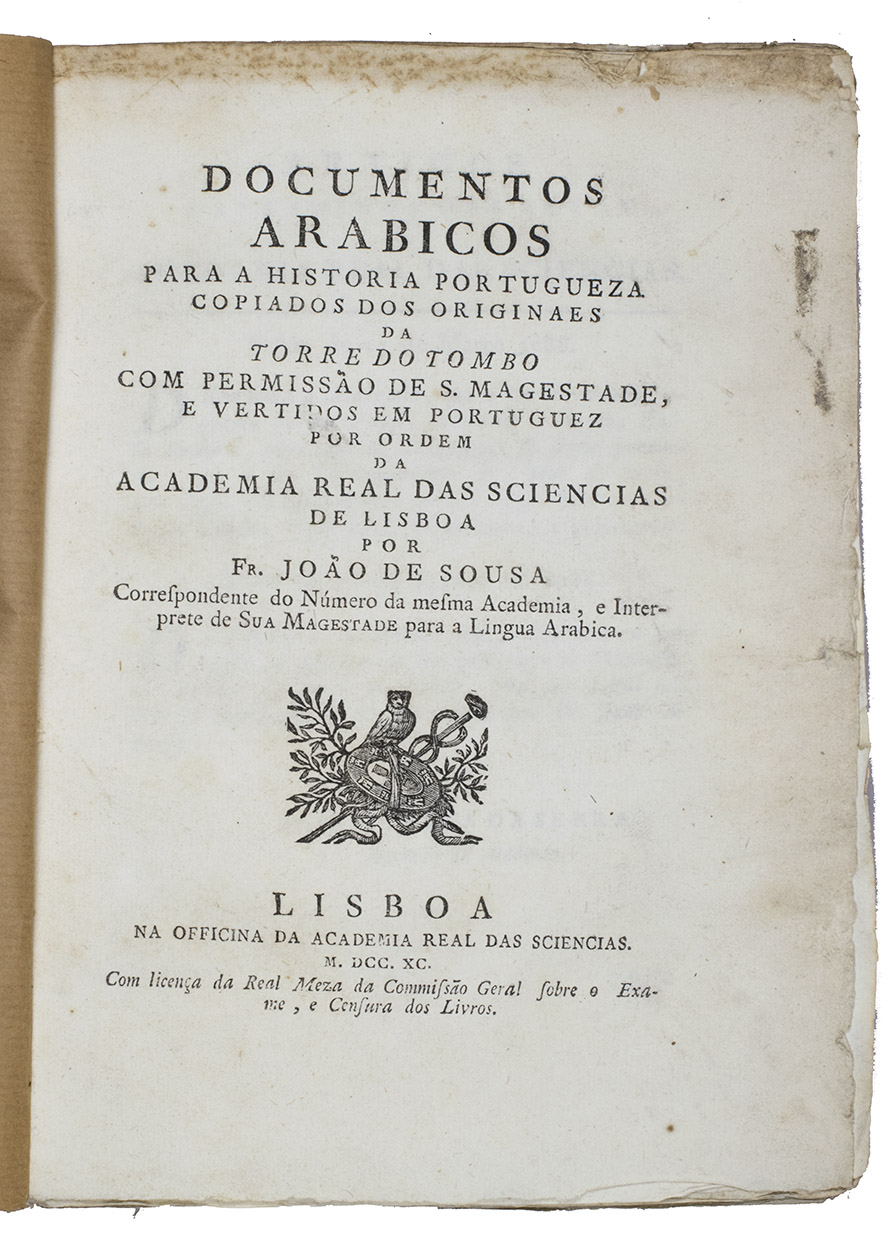
Author: SOUSA, João de.
Title: Documentos Arabicos para a historia Portugueza...Lisbon, Academia Real das Sciencias, 1790. 4to. With the academy's woodcut device on the title-page (incorporating the Portuguese coat-of-arms, Athena’s owl and Hermes’s staff). Set in roman, Arabic and italic types. Modern brown paper wrappers. Wholly untrimmed and with most of the bolts unopened, preserving all deckles and point holes.
Description: [8], 190, [2] pp.First and only edition of a collection of letters written in Arabic during the reigns of Kings Manuel I and João III of Portugal (numbered 1-58 in chronological order, the dated letters from 1503 to 1528), from the official Portuguese state correspondence, with the original Arabic and a parallel Portuguese translation. The letters came from North Africa, the Gulf, East Africa, India and the East Indies. The writers include kings, princes, governors, wazirs, sheikhs and noblemen, including Kings “Mahomed Xáh” and “Mir Abanasar” of Ormus, King “Azarkam” of Barus in Sumatra, and kings of Fez, Malindi and Calicut/Kozhikode. They are especially important for the light they shed on Portugal’s East Indian trade, but also provide a rare primary source of information about Islamic leaders for whom little documentation has survived. The original Arabic appears in the inside columns with the Portuguese translation in the outside columns, and the apparatus and notes are in Portuguese. João de Sousa (1734-1812), born in Damascus, came to Portugal in 1750 and was appointed the first professor of Arabic at the University of Lisbon.The Royal Printing Office in Lisbon had used the present Arabic type in 1774 for Antonio Baptista, Instituições da lingua Arabica. The form of the Arabic type may have been influenced by Robert Granjon’s of this size, cut in 1586, his smallest Arabic, which was at this time in possession of the Propaganda Fide in Rome, but the direct model and the circumstances of the cutting remain unknown. The type here measures 96 mm/20 lines (14 point). It is not the Arabic type acquired by the Biblioteca Real in Madrid in 1751 for the 1760 Bibliotheca Arabico-Hispana, which came from the Voskens and Clerk foundry in Amsterdam.Title-page slightly soiled and foxed in the upper margin, with a few small marginal tears, but overall a very good copy. A remarkable primary source for numerous Arabic-speaking leaders and their relations with Portugal in the early 1500s.l Macro, Bibl. Arabian peninsula 2098; Palau 320779; Schnurrer, Bibl. Arabica 186; not in Atabey; Blackmer.
Keywords: [9EE06DC76F16] ASIA|[9EE06DC76F16] ASIA -> [2E35157B4164] India & Sri Lanka|[9EE06DC76F16] ASIA -> [840DBD7F7389] Southeast Asia|[7F0260752519] EUROPE|[7F0260752519] EUROPE -> [C4A41CECF93A] Spain & Portugal|[BFFF1D78AE20] HISTORY, LAW & PHILOSOPHY|[BFFF1
Title: Documentos Arabicos para a historia Portugueza...Lisbon, Academia Real das Sciencias, 1790. 4to. With the academy's woodcut device on the title-page (incorporating the Portuguese coat-of-arms, Athena’s owl and Hermes’s staff). Set in roman, Arabic and italic types. Modern brown paper wrappers. Wholly untrimmed and with most of the bolts unopened, preserving all deckles and point holes.
Description: [8], 190, [2] pp.First and only edition of a collection of letters written in Arabic during the reigns of Kings Manuel I and João III of Portugal (numbered 1-58 in chronological order, the dated letters from 1503 to 1528), from the official Portuguese state correspondence, with the original Arabic and a parallel Portuguese translation. The letters came from North Africa, the Gulf, East Africa, India and the East Indies. The writers include kings, princes, governors, wazirs, sheikhs and noblemen, including Kings “Mahomed Xáh” and “Mir Abanasar” of Ormus, King “Azarkam” of Barus in Sumatra, and kings of Fez, Malindi and Calicut/Kozhikode. They are especially important for the light they shed on Portugal’s East Indian trade, but also provide a rare primary source of information about Islamic leaders for whom little documentation has survived. The original Arabic appears in the inside columns with the Portuguese translation in the outside columns, and the apparatus and notes are in Portuguese. João de Sousa (1734-1812), born in Damascus, came to Portugal in 1750 and was appointed the first professor of Arabic at the University of Lisbon.The Royal Printing Office in Lisbon had used the present Arabic type in 1774 for Antonio Baptista, Instituições da lingua Arabica. The form of the Arabic type may have been influenced by Robert Granjon’s of this size, cut in 1586, his smallest Arabic, which was at this time in possession of the Propaganda Fide in Rome, but the direct model and the circumstances of the cutting remain unknown. The type here measures 96 mm/20 lines (14 point). It is not the Arabic type acquired by the Biblioteca Real in Madrid in 1751 for the 1760 Bibliotheca Arabico-Hispana, which came from the Voskens and Clerk foundry in Amsterdam.Title-page slightly soiled and foxed in the upper margin, with a few small marginal tears, but overall a very good copy. A remarkable primary source for numerous Arabic-speaking leaders and their relations with Portugal in the early 1500s.l Macro, Bibl. Arabian peninsula 2098; Palau 320779; Schnurrer, Bibl. Arabica 186; not in Atabey; Blackmer.
Keywords: [9EE06DC76F16] ASIA|[9EE06DC76F16] ASIA -> [2E35157B4164] India & Sri Lanka|[9EE06DC76F16] ASIA -> [840DBD7F7389] Southeast Asia|[7F0260752519] EUROPE|[7F0260752519] EUROPE -> [C4A41CECF93A] Spain & Portugal|[BFFF1D78AE20] HISTORY, LAW & PHILOSOPHY|[BFFF1
Price: EUR 4500.00 = appr. US$ 4890.81 Seller: A. Asher & Co. B.V.
- Book number: ABC_46815
- Book number: ABC_46815